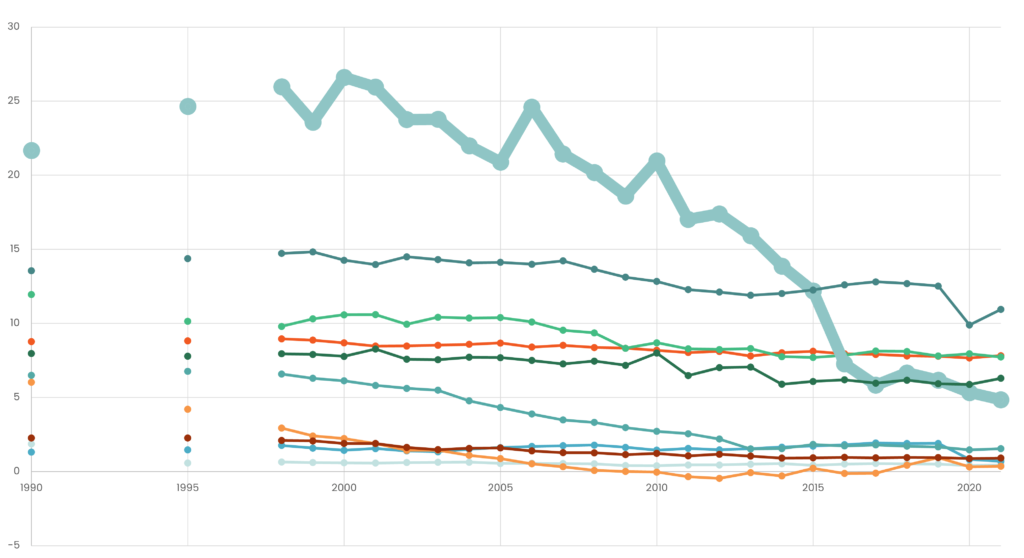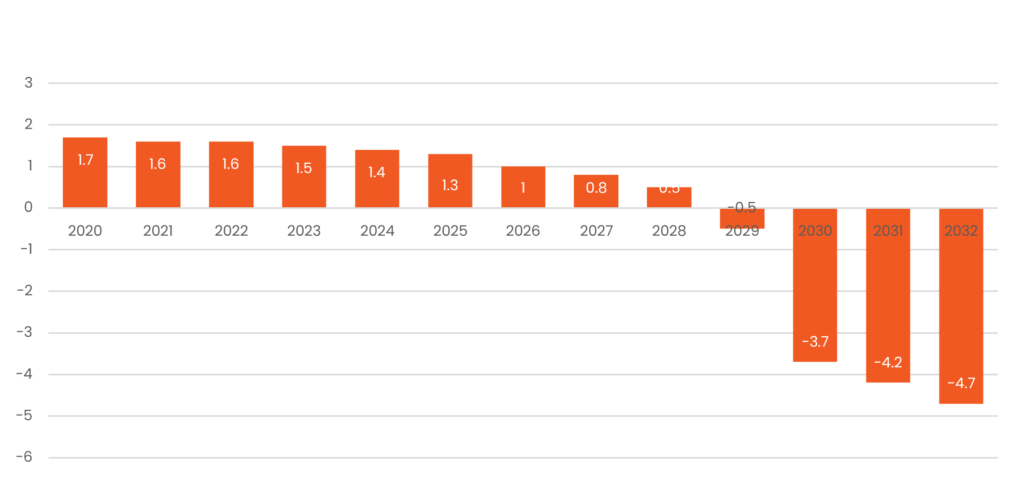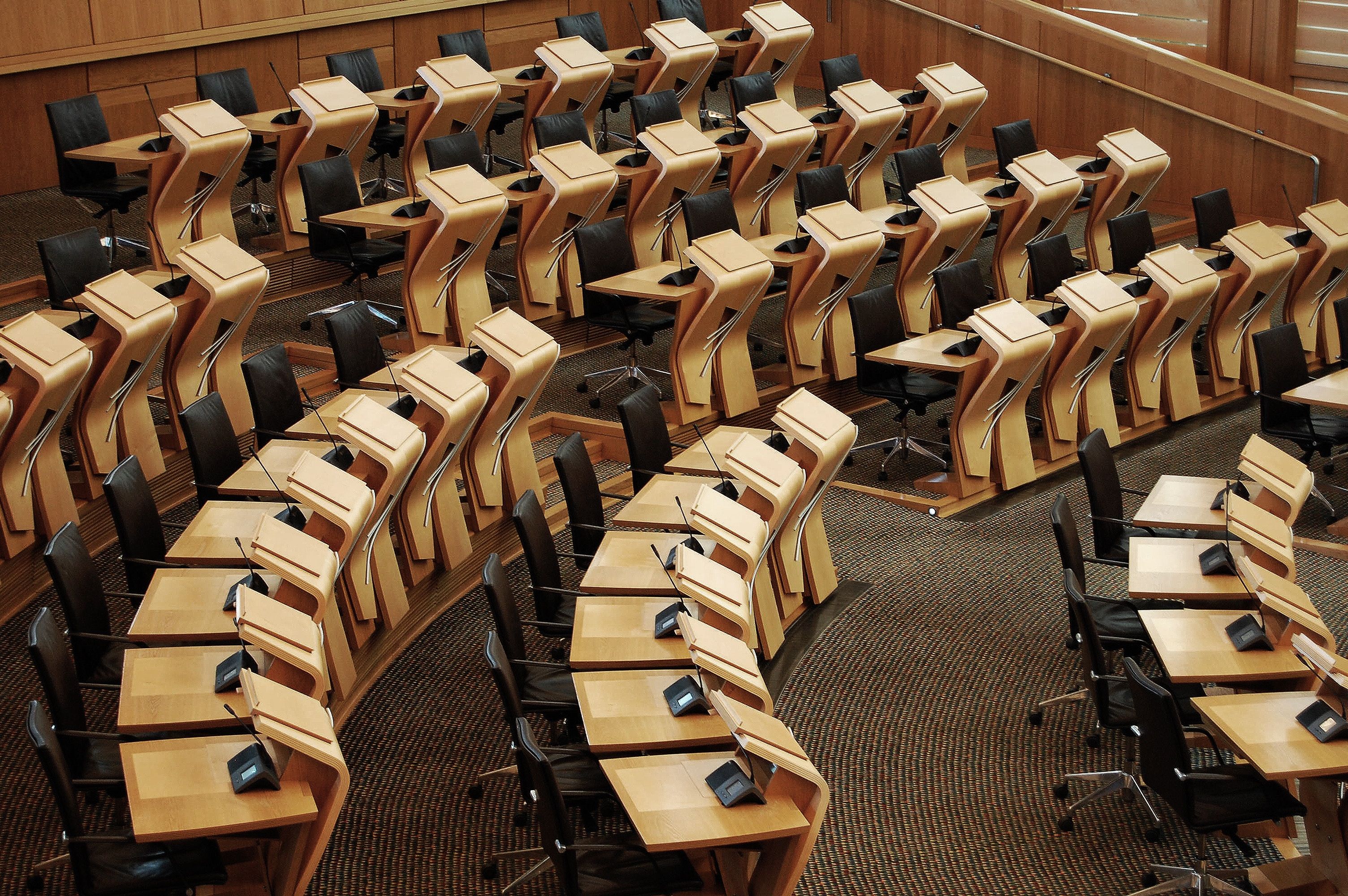Energy including electricity
Emissions from the energy sector cover emissions from fuel combustion for electricity and other energy production sources, and fugitive emissions from fuels.103 Emissions fell 77% between 1990 and 2021.104
The emissions from the oil and gas industry that take place offshore are not included in Scotland’s totals. In 2020 this came to an additional 3.6MtCO2e for venting and flaring from offshore installations and most of another 3.8 MtCO2e from exploration, production and transport of oil and gas.
From figures in Scottish Greenhouse Gas Statistics 2021, Scottish Government, 2023, https://www.gov.scot/binaries/content/documents/ govscot/publications/statistics/2023/06/scottish-greenhouse-gas-statistics-2021/documents/scottish-greenhouse-gas-statistics-2021/ scottish-greenhouse-gas-statistics-2021/govscot%3Adocument/scottish-greenhouse-gas-statistics-2021.pdf
Read this chapter
The electricity sector is a big success story in Scotland in reducing emissions, thanks to the growth of renewable energy and the closure of Scotland’s two coal-fired power stations. Electricity accounts for about a fifth of our energy use, and non-electricity energy use also appears in other sections of this report. An urgent priority is to accelerate the transition from fossil fuels to renewable electricity in every application that we can, especially in building and water heating, and transport.
In the midst of an energy cost of living crisis it is galling to realise that Scotland ought to be well placed to avoid the worst of the price rises. Our electricity industry has been through a major transition away from fossil fuels, with renewable energy schemes supplying the equivalent of 97% of our electricity demand in 2020. However, electricity is traded regionally and internationally. Therefore, the price of UK grid electricity is closely related to the rising cost of gas, even though Scotland’s one remaining fossil-fuel power station – the gas-fired station at Peterhead – produces rather little of our electricity. Because electricity prices are artificially high the Treasury predicts that UK gas producers and electricity generators may make £170bn in excess profits over a two year period.105 Similarly, we have our own oil industry and their costs have not risen significantly, but this has been no buffer to big increases in the price of road fuels and gas for heating because oil and gas are also internationally-traded commodities.
Scotland’s territorial emissions 1990-2021

Emissions in MtCO2e from the energy sector 1990-2021, showing a fall of 77% (bold teal line)
The main barriers to further climate progress in the energy sector include the proposed new gas-fired power station at Peterhead, which could see both the old and new plants running with neither of them capturing any carbon, the potential rebuild of the Grangemouth oil refinery and the slow speed of renewables deployment. Further barriers are the lack of a finalised Just Transition plan to support workers in shifting from high carbon energy sector jobs, and the slow pace of new job creation in renewable energy supply chains in Scotland and the UK. The renewables industry says there is no shortage of investment capital but that central and local government processes can take a long time, pointing to a lack of capacity among local authorities and statutory consultees.
UK Sees Up to £170 Billion Excess Profits for Energy Firms, Bloomberg, 30 August 2022, https://www.bloomberg.com/news/articles/2022-08-30/uk-predicts-up-to-170-billion-excess-profits-for-energy-firms
The Climate Change Plan update, in its chapter about electricity, lists three outcomes along with policies and proposed policies supposed to deliver them:
Outcome 1: The electricity system will be powered by a high penetration of renewables, aided by a range of flexible and responsive technologies.
Outcome 2: Scotland’s electricity supply is secure and flexible, with a system robust against fluctuations and interruptions to supply.
Outcome 3: Scotland secures maximum economic benefit from the continued investment and growth in electricity generation capacity and support for the new and innovative technologies which will deliver our decarbonisation goals.
The Plan shows emissions from electricity generation declining and then becoming strongly negative from 2029 (the graph published in the Climate Change Plan update only shows the positive emissions out to 2028 but not the negative emissions after this date, although these are included in the listed annual overall totals). The plan also says “the development of carbon capture and storage and NETs will mean that the electricity system in 2032 could potentially deliver negative emissions.” Both the Committee on Climate Change106 and the Scottish Government’s own progress monitoring107 have said that this is very unlikely to happen on this timescale.
Electricity sector emissions 2020-2032 (MtCO2e)

Expected climate change emissions from the electricity sector 2020-2032
At the time of writing the Scottish Government was consulting on its draft Energy Strategy and Just Transition Plan.108 The draft Energy Strategy predicts improvements in the efficiency of using energy in heating buildings, transport, industry and agriculture by 2030. It also sets a goal of a largely decarbonised energy sector by 2030, so much less of this will be from fossil fuels; electricity use in Scotland is therefore predicted to increase by 60% by 2030 and by 85% by 2045, from 2020 levels.
Progress reducing emissions in Scotland – 2021 Report to Parliament, Climate Change Committee, 2021, https://www.theccc.org.uk/ publication/progress-reducing-emissions-in-scotland-2021-report-to-parliament/
Climate Change Plan Monitoring Reports, Scottish Government, 2022, https://www.gov.scot/binaries/content/documents/govscot/ publications/progress-report/2022/05/climate-change-plan-monitoring-reports-2022/documents/climate-change-plan-monitoringreports- 2022/climate-change-plan-monitoring-reports-2022/govscot%3Adocument/climate-change-plan-monitoring-reports-2022.pdf
Draft Energy Strategy and Just Transition, Plan, Scottish Government, January 2023, https://www.gov.scot/publications/draft-energystrategy- transition-plan/documents/ & SCCS response https://www.stopclimatechaos.scot/wp-content/uploads/2023/05/SCCS-ESJTPresponse- May-2023.pdf

